Environmentalism Art – Environmental Art and Its Importance
Environmental art has existed as far back as when ancient man depicted lightning and rain on the walls of their caves. For many centuries, environmental painters focused on the beauty of landscapes, and used landscapes as appealing backdrops for their human subjects in their works. However, since the 20th century, Environmentalist art and Climate Change art have emerged in response to the alarming environmental issues facing our planet. Environmentalist artists now use their works to draw attention to this plight, and to help raise awareness of our impact on the environment.
Contents
An Introduction to Environmentalism Art
Since the 1990s, Environmental art has progressively gained traction as Environmental painters express the necessity to view the environment as an integrated system in which humans are an integral element, and not just a resource to be depleted for personal gain. By doing so, Environmentalism artists hope to redefine our connection to our natural surroundings. Environmental art is often created outdoors, such as with landscape paintings, and they can often incorporate natural materials too.
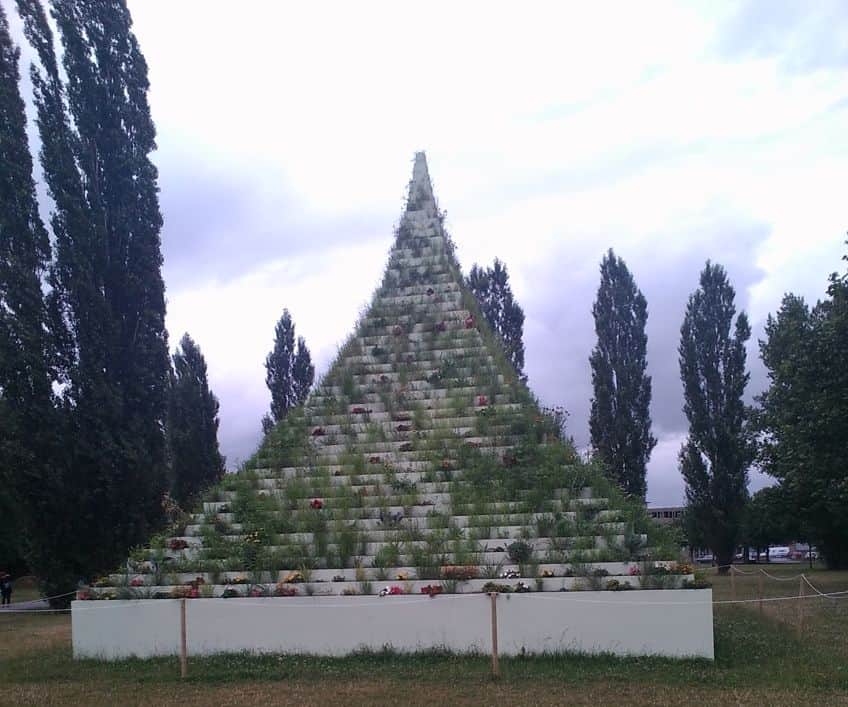
The History of Environmental Art
Environmental art refers to a variety of forms and techniques that interact with and reflect the environment. What makes Environmentalism art distinct is that it is not tied to a specific period of time or art form. Environmentalist artists strive to work in harmony with nature instead of destroying it.
However, Environmental painters can be traced back to the art of landscape painting.
Landscape Art
The natural environment has always inspired artists as both the background and the main focus, its beauty giving an ever-present sense of fascination through the years. In their works, European High Renaissance painters regularly appreciated and attempted to reproduce the beauty of the natural world. Later, naturalist artists like John Constable juxtaposed images of residences and agricultural details with realistic portrayals of the British environment. The French Barbizon School, influenced by Constable, attempted to depict actual life among nature:
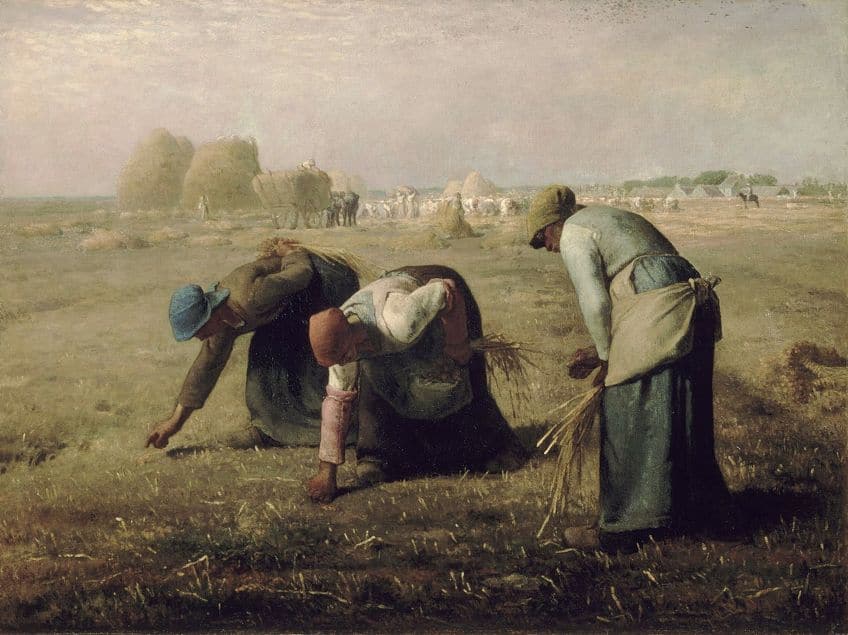
The Gleaners (1857) by Jean-François Millet is among this school’s most known paintings with its depiction of individuals working on the land. Impressionists challenged the boundary between the focus point and the backdrop of a specific artwork in the 19th century with more relaxed compositions, such that works felt like glimpses of a moment instead of static representations. The Hudson River School was crucial to the establishment of a certain aesthetic in America in the 19th century, as artists like Thomas Cole sought ways to express the magnificent idiosyncrasies of the new continent.
Nevertheless, some artists and critics started to realize that the typical arrangement of landscape paintings portrayed nature as too beautiful and too constrained: what we saw in a landscape wasn’t really nature in and of itself, but a representation of the environment as seen through the artist’s eyes.
This gave rise to a new landscape category, and it was only natural for painters to shift their view of the world from simple subject matter to a real thing with which we might begin to consider our varied connections. As painters started to examine humanity’s existence in this manner, they began to analyze our physical interaction with, and sometimes hostility to, our natural world.
The Emergence of Conceptual Art
As many painters drifted away from realism in the early 20th century, they also drifted away from painting natural landscapes in the manner of previous centuries. Rather than just a subject on canvas, some painters started to create more conceptual works that took place outside of nature or even used nature as a primary medium in their works. These projects prioritized location, material, and technique over preconceived notions of a finished product.
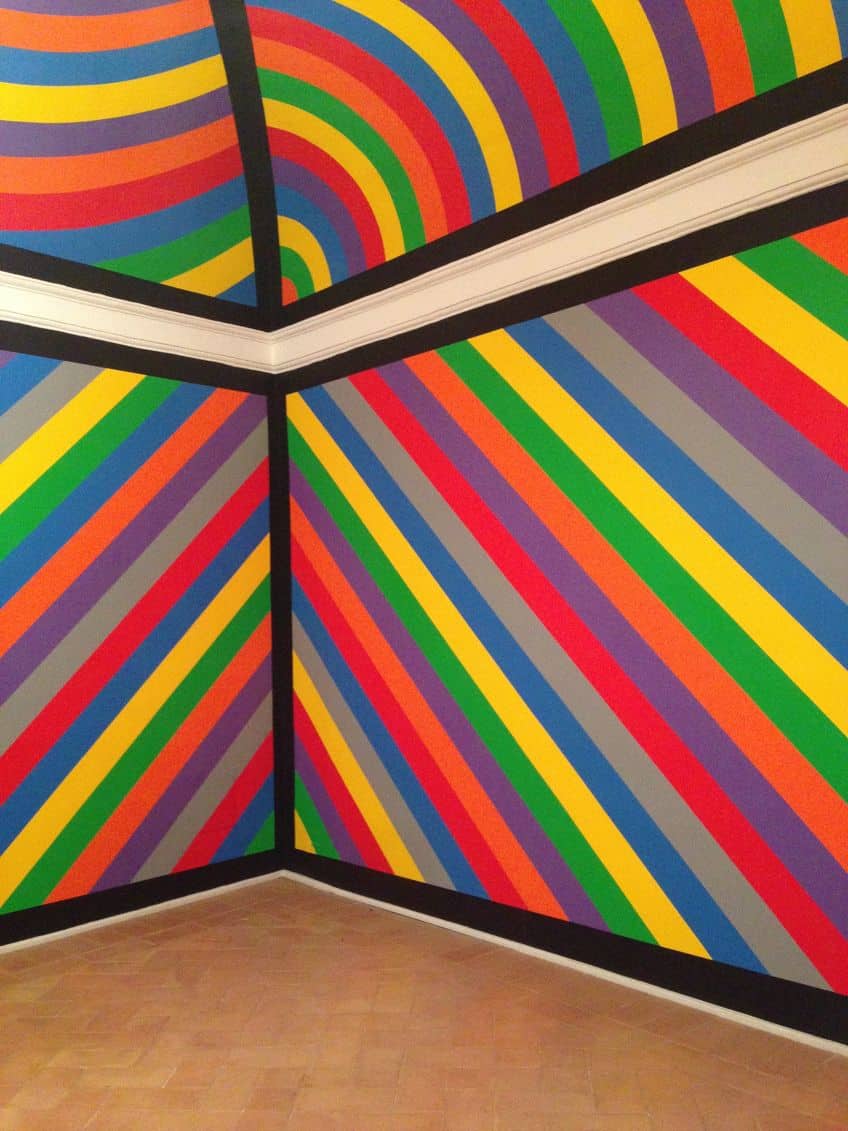
In 1969, artist Joseph Kosuth published Art after Philosophy as a critique of modernism’s dominance in the art world, challenging painters to reconsider what art might achieve and how a viewer may respond. Sol LeWitt and Joseph Beuys, for example, created intricate and layered pieces that traveled from the gallery space to new and creative places.
Earth Art
Earth art was a notable avant-garde art movement in the 1960s and 1970s, led mostly by American artists. It evolved from Minimalism, which advocated for a new purity as well as growing dissatisfaction with the traditional market’s dominance and hierarchy. It also shared many similarities with Conceptual Art in its emphasis on process over execution. Many emerging artists were concerned with the constraints of the gallery space at the time, and the counterculture scene was urging people to reassess power systems and how to effectively work outside of them.
Artists started to explore areas in urban wastelands and deserts to exhibit various types of work, some of which had unusual compositions and sizes.
Spiral Jetty (1970) by Robert Smithson is regarded as a pivotal piece of Earth Art; in creating a gigantic spiral in a salt flat in Utah, Smithson referenced the great scale and grandeur of nature itself. Smithson, together with Michael Heizer, Nancy Holt, and Walter de Maria, constructed works out of stone, rock, and sand. Environmentalism art endeavored to make it easier to use and collaborate with natural materials. Indeed, Robert Smithson and others have been chastised for the environmental harm caused by their creations: practices like cutting chunks out of the soil, drilling, excavating, and transporting heavy load materials such as stone did not appropriately exhibit a concern for humans’ influence on nature.

These criticisms emerged as a result of a growing global environmental consciousness. Rachel Carson’s book Silent Spring (1962), examined the harmful impact of pesticides on the environment. It projected the impact of toxic chemical usage and buildup in insects and animals and provided recommendations for pesticide alternatives and pest-reduction techniques. The publication had a significant effect on the public’s awareness of human influence on the natural environment, and it resulted in the development of various environmental justice and advocacy organizations. In 1970, Richard Nixon’s administration founded the Environmental Protection Agency to resolve many of Carson’s concerns.
Earth Day was established in the same year and is now observed every year on April 22. The intended purpose of the day is to try to raise awareness of the many different environmental challenges that the planet is now facing.
Around the same time, the first Green Parties were established in an effort to highlight issues raised by environmental justice organizations and concerned citizens. Since then, as scientists have warned of the catastrophic effects that environmental change would have on people’s daily lives all over the world, global warming and climate change have taken a more prominent place in the platforms of various political parties and giving rise to Climate Change art.
Later Developments
Environmentalist artists began to address the real legacy and influence of art in the environment in the 1990s and early 2000s, and how their works might actively attract attention to specific challenges occurring in otherwise unnoticed or unrecorded locations. Sue Spaid, an artist, and curator Amy Lipton invented the word “ecovention” to describe art that had a far more precise goal than just conveying a concept, but that was an “intervention” of some form to help in the improvement of a specific situation.
The two staged an exhibition at Cincinnati’s Contemporary Arts Center around this subject, exhibiting numerous instances of Environmentalism artwork, and published an accompanying book, establishing this concept as a unique aesthetic trend.
In the use of material or inspiration taken from nature and natural phenomena, environmentalism art has had a significant effect on public and Installation art. In recent years, artists like Ann Veronica Janssens and Olafur Eliasson have highlighted the direct effect of transient environmental experiences in the gallery space through the production of artificial natural occurrences. The Weather Project (2003), for instance, recreated the impression of a massive setting sun within the famous Turbine Hall of the Tate Modern, bringing the sky indoors.
Important Environmental and Climate Change Artworks
Environmental painters frequently base their work on natural elements such as flowers, leaves, ice, dirt, branches, stone, sand, and water. Additionally, by situating their works in specific locations, environmentalist artists typically strive to simultaneously modify the way the site is perceived while also disclosing what was previously there. This necessitates that observers and audiences reconsider how they experience the world around them and pay more attention to the minute and unique elements that comprise a coherent environment. Environmental art, which evolved from Land Art, rethinks the role of the gallery space and considers new areas where art might happen and exist.

This type of institutional critique tries to bring into doubt the power and authority of galleries and museums which have traditionally dominated the creation, purchase, and consumption of artworks. By seeking out new, and often unexpected settings, artists not only deprive high-powered art dealers and purchasers of authority but also call into question the necessity for the public and art consumers in general. Artists, on the other hand, emphasize the genesis of an idea and the production process without asking that the piece be viewed by a large number of people, or even by anybody at all.
Ocean Landmark (1970) by Betty Beaumont
| Artist | Betty Beaumont (1946 – Present) |
| Date | 1970 |
| Medium | Inert coal waste |
| Location | Atlantic Ocean, New York Harbor, United States |
Betty Beaumont’s art is extremely socially conscious, usually emphasizing sustainability and dealing with current concerns. Beaumont was searching for a technique to transform waste material from a power plant to create something that would actively assist the environment when she created this sculpture. She worked with a group of scientists to build the sculpture, which is now floating in the Atlantic Ocean 40 miles from New York Harbor. Beaumont was able to create an artificial reef deep beneath the sea by collecting coal waste and reconstructing it into inert blocks.
Despite the fact that audiences are not able to view the artwork due to its location, New York University’s Interactive Telecommunications Program built a virtual reality simulation of it in 2000.
The sculpture raises fundamental questions regarding Conceptual art’s ability to have a beneficial influence on the environment. Beaumont demonstrated how interconnected her creative approach is with environmental studies and exploratory ecology in this piece’s preparatory work with engineers and scientists. By integrating art with science, she bridged the gap between fields and proposed new cross-disciplinary modes of work, notably in the solution of pressing challenges such as the recycling and repurposing of industrial waste. Furthermore, by situating her work beneath the water, she addressed the issues of an active and passive reaction in her audiences: how can we react to this piece as an aesthetic object or as an illustration of activism?
Wheatfield, a Confrontation (1982) by Agnes Denes
| Artist | Agnes Denes (1931 – Present) |
| Date | 1982 |
| Medium | Wheat and soil on a landfill |
| Location | Manhattan, New York City, United States |
Agnes Denes is a well-known environmental artist who creates work that challenges the limits of what art can be while also crossing over into other fields such as activism. This is one of her most well-known and demanding compositions. Denes developed a two-acre wheat crop in a Lower Manhattan waste site with the aid of many volunteers. The site was readied with soil, wheat was sown and subsequently harvested. The piece lasted three months.
The location was critical to the success of this project. At the time, the property was completely deserted and had not yet been built, making it the ideal urban wasteland to revive.
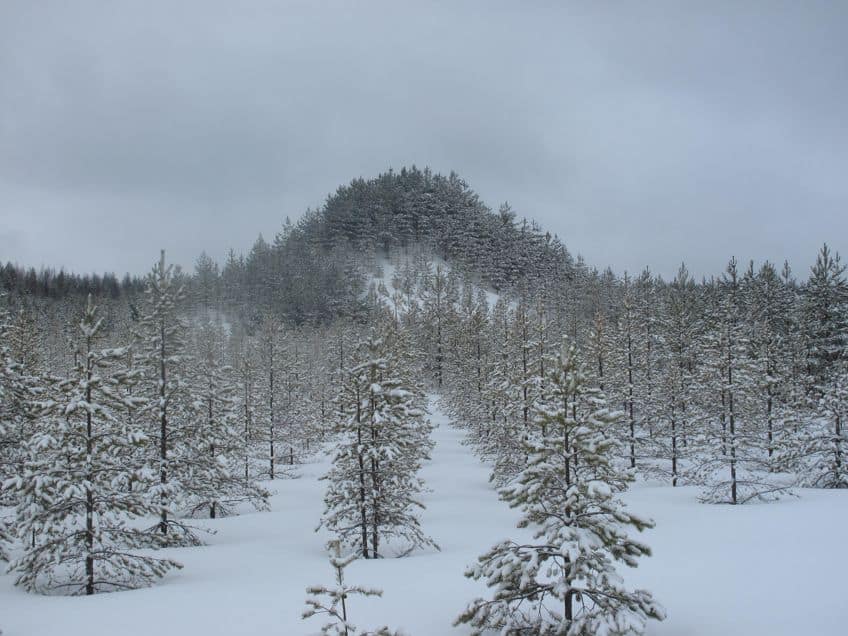
However, there are other essential characteristics regarding the site. The installation appeared to look down at the World Trade Center, one of New York’s most potent icons, and compel the visitor to address challenging issues about the rich-poor gap, the pastoral-technocratic divide, and how people embrace development. Though her affinity for urban deterioration may resemble Robert Smithson’s artwork, the art’s transient nature ensures that instead of leaving a permanent mark on the land, Denes’ work is only remembered through memory, photographs, or word of mouth.
Pinfold Cones (1985) by Andy Goldsworthy
| Artist | Andy Goldsworthy (1956 – Present) |
| Date | 1985 |
| Medium | Limestone cones |
| Location | Brough, Cumbria, North England |
Andy Goldsworthy is well-known for his site-specific works that celebrate organic patterning, form, and texture while exploring the intrinsic beauty of nature, the unavoidable cycles of rebirth and death, and the co-creation of mankind and natural material. He has remarked that he considers his art to be a “union with nature”. We witness this unity in this example via his tremendous appreciation for what nature has to give to anybody who takes the opportunity to look attentively.
Goldsworthy stayed in Cumbria, North West England, for four years, working as a gardener while producing these limestone forms. He painstakingly picked local limestone and piled the pieces into a distinctive cone form.

He’s amazed by how a cone grows, stone atop the stone, layer upon layer – much like a tree, ring upon ring. The form may be broadened out or taken in by making tiny modifications in the placement of each stone, making it beautiful or squat, empty or full. Goldsworthy designed a unique shape for each cone, inspired by the inherent contours and edges of the stones themselves. Goldsworthy claimed that using natural resources to create is an ancient, fundamental human drive, and he loves emulating the design and composition of the older cairns. Although the piece could not be purchased or sold, it sent a strong message to onlookers that they, too, could create their own replicas of historical items and therefore add to the concept of geographical legacy.
Double Bed for Dreaming (1988) by Meg Webster
| Artist | Meg Webster (144 – Present) |
| Date | 1988 |
| Medium | Peat moss and soil |
| Location | Brooklyn Museum, Brooklyn, New York City, United States |
Meg Webster frequently incorporates flowers, gardens, and plants into the exhibition space. These pieces, however, are not just recreations of an English rural garden or the atmosphere of a flower fair. Instead, she actively adjusts the atmospheric temperature of the gallery with her ecological recreations by using lighting, organic material, and heat. The basic presentation of a circular rectangle of peat moss and earth in this painting shows the influence of Minimalism.
The components used to make it are the fundamental foundations of our life since they give the essential beginning points for plants, which nourish us and other living things.
Though this may seem apparent, Webster reveals the underlying, ever-present enchantment of the environmental processes that occur discreetly all around us by sculpting these natural materials in such an understated manner. However, by putting it into the gallery environment, she was able to underline its value and encourage visitors to examine something that is normally overlooked as art. Additionally, by employing earth, with its distinct scent and appearance, she informed audiences that nature is more than simply a visual presence; it is also a physical presence.
The Weather Project (2003) by Olafur Eliasson
| Artist | Olafur Eliasson (1967 – Present) |
| Date | 2003 |
| Medium | Monofrequency lights, projection foil, haze machines, mirror foil, aluminum, and scaffolding |
| Location | Turbine Hall of Tate Modern, London, United Kingdom |
Olafur Eliasson has created various works that directly harness the force of the weather in order to add a new experience element to the visual encounter. Eliasson is concerned with dissolving the boundaries between the interior and outside through our body’s response to the main components that comprise life on Earth, and he frequently uses water and light to do so. The Weather Project is made up of hundreds of yellow lamps affixed to the wall in the shape of a half-sun. This half-sun is then mirrored by reflective foil on the ceilings, giving the illusion of a whole blazing orb.
The vast expanse is then misted such that when visitors wander across it, they become slightly moist, as though moving through London fog.
Eliasson employed mono-frequency lighting, which made only yellow and black visible, creating a sensation similar to strolling through shadows. Eliasson emphasized the way we typically regard the weather as a minor background aspect in our lives by replicating the weather inside. Though the weather could affect our ability to engage in particular activities, it is generally assessed mainly in terms of its impacts on us instead of as an essentially alive thing in its own right. This is especially obvious while living in a metropolis.
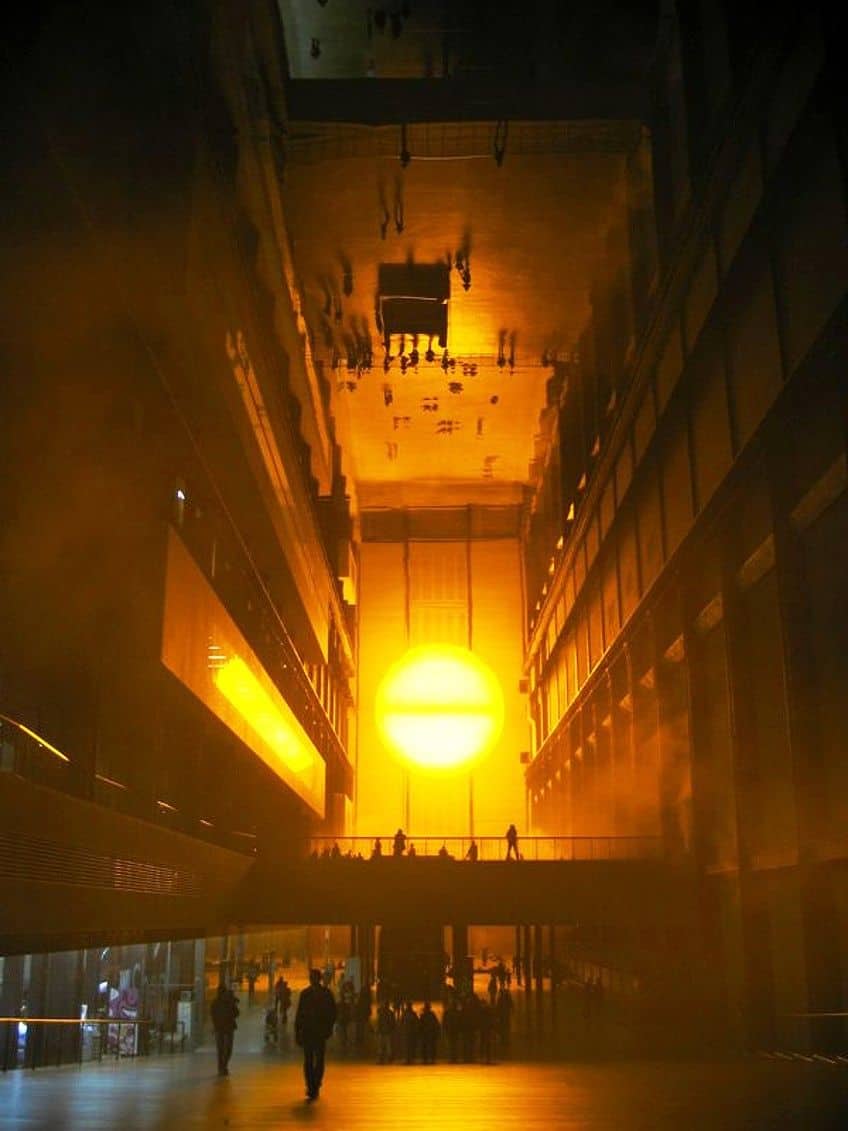
Humans used to live in balance with the climate and relied on it to preserve their way of life in previous agricultural economies. For those who reside in cities, it may just be an annoyance. Eliasson stated that he intended the research to address this issue “Every city has its own weather system. We have become used to the weather as it is mediated by the city as residents”. He attempts to isolate the weather from its environment by making it an activity in this prominent urban museum, allowing us to perceive its complexity and subtleties in a new light.
Whereas in previous eras Environmental painters sought to portray the sheer natural beauty of the environment, modern Climate Change artists want to engage with their audiences and impart a deeper message with their Environmentalism artworks. This could be through works about nature, works that are created in nature itself, or works that incorporate elements of nature in their design. Every Environmental artist has their own unique way of involving the audience and depicting their messages.
Frequently Asked Questions
What Is Environmentalism Art?
Environmental art explores political and social concerns impacting the natural and urban environments. Installation is a common kind of environmental art. The word first appeared in the late 1960s and is frequently associated with land art.
What Do Environmentalist Artists Hope to Achieve?
Environmentalist artists aim to raise public awareness of environmental challenges and motivate individuals to act in order to safeguard the environment. They utilize their work to inform others about the harmful effects of human activities on the environment and the significance of protecting natural resources. They hope to motivate individuals to take initiatives to reduce their environmental impact, and to campaign for legislation that will help safeguard the world through their work. Additionally, some environmental artists want to foster a deeper sense of connectedness with and respect for the natural world.
Jordan Anthony is a Cape Town-based film photographer, curator, and arts writer. She holds a Bachelor of Art in Fine Arts from the University of the Witwatersrand, Johannesburg, where she explored themes like healing, identity, dreams, and intuitive creation in her Contemporary art practice. Jordan has collaborated with various local art institutions, including the KZNSA Gallery in Durban, the Turbine Art Fair, and the Wits Art Museum. Her photography focuses on abstract color manipulations, portraiture, candid shots, and urban landscapes. She’s intrigued by philosophy, memory, and esotericism, drawing inspiration from Surrealism, Fluxus, and ancient civilizations, as well as childhood influences and found objects. Jordan is working for artfilemagazine since 2022 and writes blog posts about art history and photography.
Learn more about Jordan Anthony and about us.
Cite this Article
Jordan, Anthony, “Environmentalism Art – Environmental Art and Its Importance.” artfilemagazine – Your Online Art Source. April 13, 2023. URL: https://artfilemagazine.com/environmentalism-art/
Anthony, J. (2023, 13 April). Environmentalism Art – Environmental Art and Its Importance. artfilemagazine – Your Online Art Source. https://artfilemagazine.com/environmentalism-art/
Anthony, Jordan. “Environmentalism Art – Environmental Art and Its Importance.” artfilemagazine – Your Online Art Source, April 13, 2023. https://artfilemagazine.com/environmentalism-art/.


